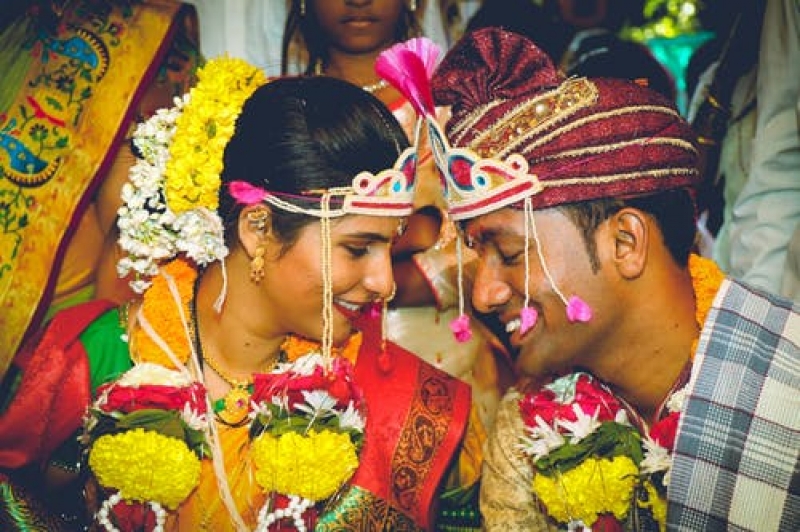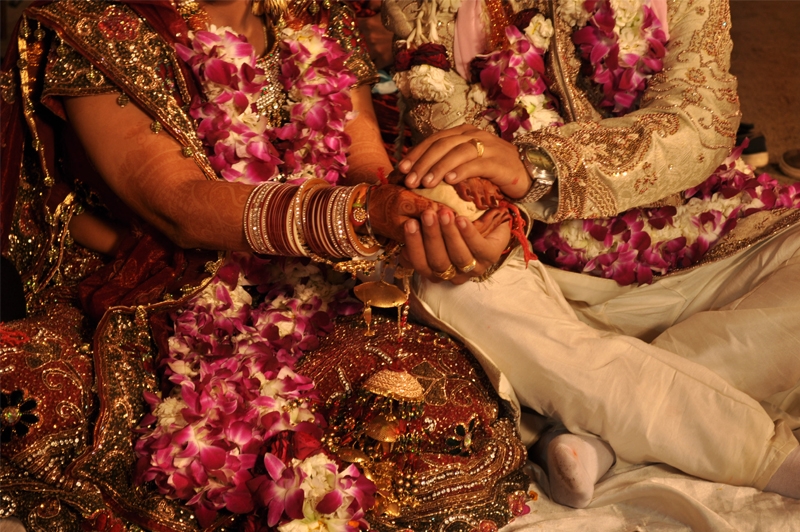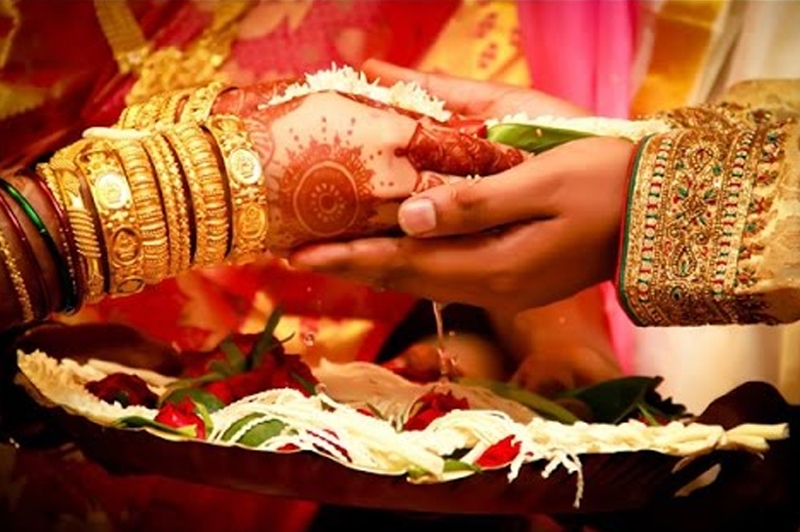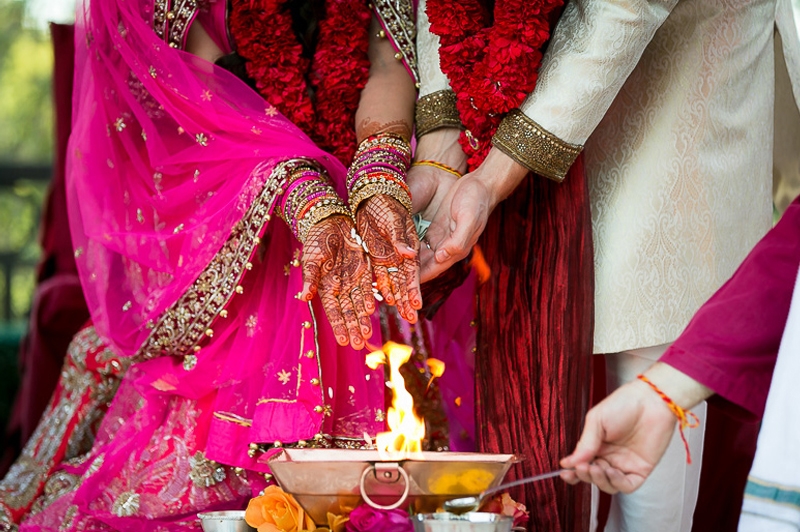
Home > Blogs > South Indian Wedding Traditions

The Hindu wedding ceremony has a number of rituals and customs, each symbolic of beautiful and noble sentiments. South Indian wedding traditions and ceremonies are no exception. As one enters the place or venue of ceremony of a South Indian wedding, one notice things such as full-grown plantain trees tied to both the gateposts, festoons overhead of mango leaves, and screw-pine petals that never fade, notes of the Nadaswaram, the South Indian Shehnai, Kolam or Rangoli designs at the doorsteps and the like.
On the evening prior to the wedding day, the bridegroom is brought in a procession from a temple in a flower-adorned ride. The bride's parents escort him to the marriage Mandapam. Nadaswaram band leads the way along the streets. After reaching the marriage hall, there is a formal ceremony of espousal. Ganapati, the God of Initiation is invoked, to keep away all hindrances. There are several presiding gods - the Nandi Devatas. To please them, a leaf-laden branch of the Pipal tree is set up, and 5 married ladies perform a ritual of washing it with milk.
This Puja or worship is followed by a presentation of a dhoti, and a saree to the espousing couple. This is performed to propitiate the 9 astral planets that rule over human destiny. The marriage ceremonies start with the Vratham performed separately by the bride and the groom. For the bride, it means the tying of the holy thread on her wrist that is meant to keep away all evil spirits. From there on, the groom prepares himself for a new chapter in his life as a householder or Grihasta. The days of his bachelorhood are now over and the acceptance of this is all what the Vratham is about.
At the marriage hall, the bride's father and the bridegroom's father facing each other, formalize the final betrothal ceremony, as the Vedic priest chants the appropriate hymns in which the names of the bride, the bridegroom, as well as the names of their 3 generations of ancestors, are cited in presence of all the friends, relatives, and guests. The bride and the groom are lifted to the shoulders of their respective uncles, and in that position they exchange flower garlands with each other thrice for a perfect union. Here the exchange of garlands symbolizes their union. It is also symbolic of acceptance of each other by exchanging the very fragrance of the other.
The bride is made to sit on her father's lap and is given away as a gift by him to the bridegroom. On the girl's head, a ring made with Kusa, is placed, and over it is placed the Mangal Sutra on the opening of the yoke, and water is poured through the aperture. The bride is then given an auspicious washing, and an elite new Koorai Saree is draped around her, which is done by the sister of the bridegroom.
The bride is made to sit on her father's lap and is given away as a gift by him to the bridegroom. On the girl's head, a ring made with Kusa, is placed, and over it is placed the Mangal Sutra on the opening of the yoke, and water is poured through the aperture. The bride is then given an auspicious washing, and an elite new Koorai Saree is draped around her, which is done by the sister of the bridegroom.
Three knots are tied, the first one by the bridegroom, the other two knots by his sister to make the bride a parts of the boy's family. The groom holds the hand of the bride. Holding the bride's hand, the bridegroom walks seven steps with her. This is the most important part of the marriage ceremony, and only when they walk seven steps together is the marriage complete. The belief is that when one walks seven steps with another, one becomes the other's friend.
A vital part of the wedding is the honor paid by the couple to Agni, the fire God. They circle around the fire, and feed it with ghee, and twigs of nine types of trees, as sacrificial firewood. The vapors that arise, are supposed to possess therapeutic, healing and purification properties for the couple. Agni, the most powerful element in the cosmos is deemed as a witness to the marriage.
The bridegroom helps her tread on a grindstone kept on the right side of the fire, holding the bride's left foot toe. The elders and the invitees shower Akshadai, or rice-grains coated with turmeric and saffron, on the couple, - as approval. Taking with her, fire from the Laaja Homam, the bride leaves her home, and enters the new home of her in-laws. The Vedic hymns sound like mother's words of advice to her daughter.
The evening of the marriage day is a time to relax and rejoice. The newly married wife calls her husband for play, alluring him through a song. Much to the cheerfulness of one and all gathered there follows list of playful items. During these items, the ladies sing songs poking fun at the bride, the groom and the in-laws. These proceedings bring out many qualities of the bride and the groom, such as sporting spirit, kindness, strength, co-operative nature and the like.
A solution of lime and turmeric powder, is prepared on a plate, and circled around, and thrown away to keep the evil eye at bay. This is done a number of times during the entire wedding ceremony, and also at the end

Hindu weddings are ceremonial feasts laden with symbolic rites and rituals. Despite India's diversities in language, culture, food and lifestyle, one can observe common threads in many Hindu weddings across Read More...

Indian Weddings with all their grandeur and magnificence have cast its spell on so many foreigners that there are many who consider getting married in India. Consequently wedding tourism in Read More...

An Indian wedding involves a lot of fun, frolic, celebrations, rituals and holy ceremonies. Indian wedding traditions are gaining popularity across the length and breadth of the world. In fact, Read More...
Search by Language : Bihari | Bengali | Hindi | Gujarati | Kannada | Malayalam | Marathi | Oriya | Punjabi | Rajasthani
Search by Religion : Hinduism | Islam | Christianity | Sikhism | Buddhism | Jainism | Others
Search by Community : Agarwal | Baniya | Khatri | Brahmin | Shia | Sunni | Rajput | Intercaste | Kshatriya | Parsi
